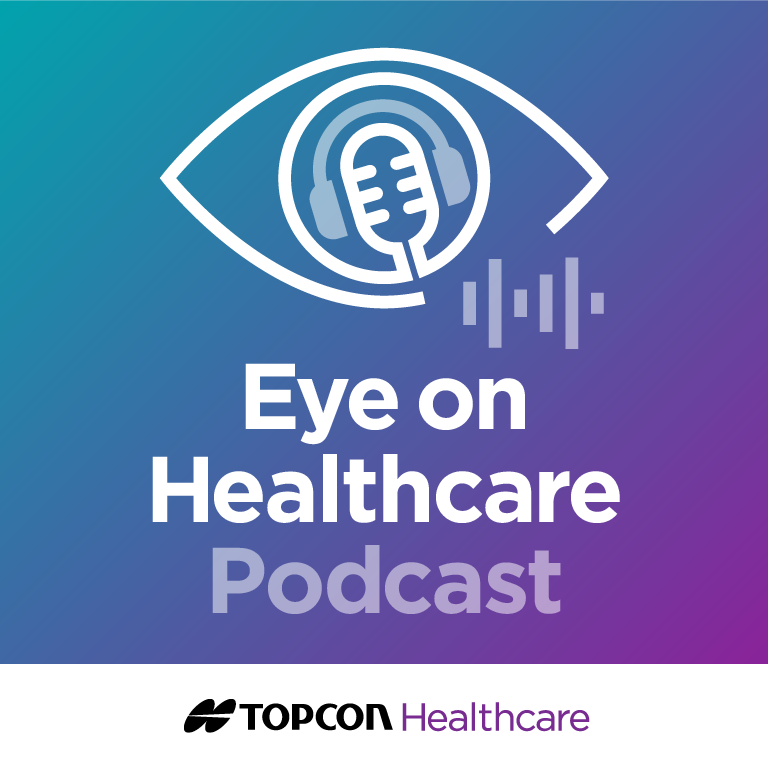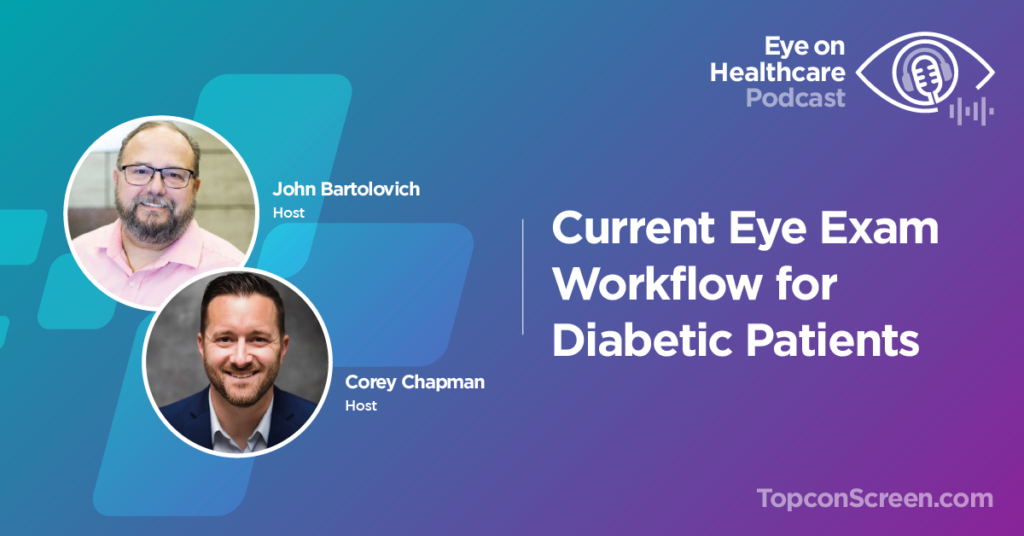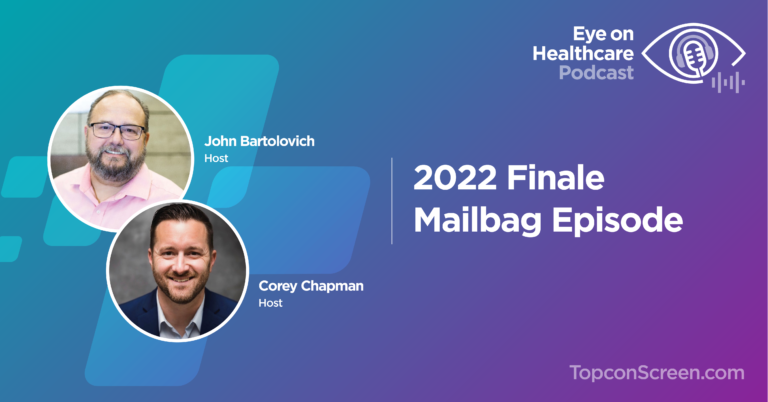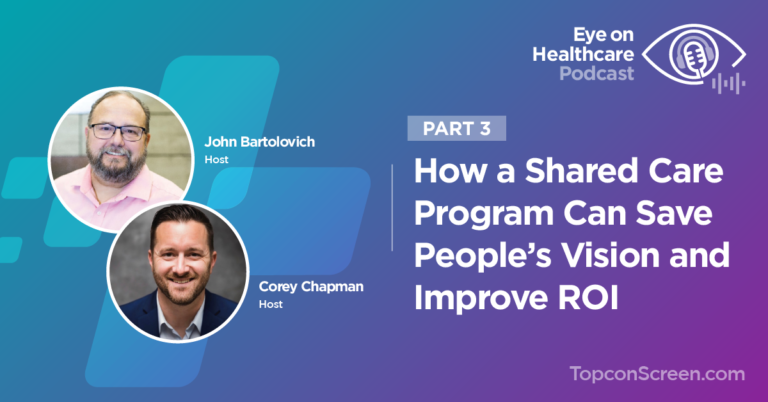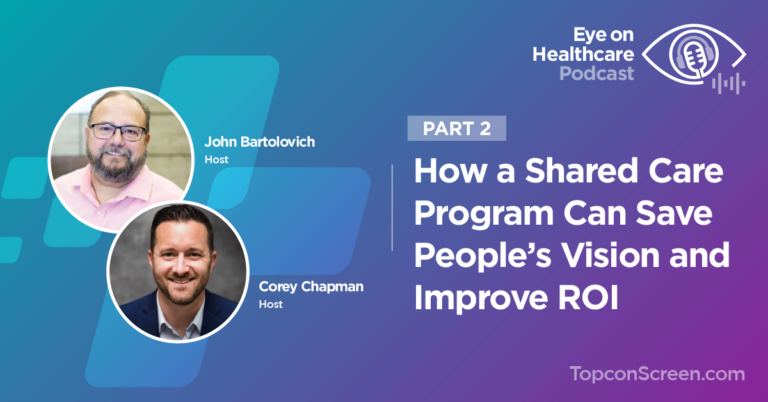Episode Transcript
Corey: Welcome to another episode of Topcon’s Eye on Healthcare podcast, your weekly dose of everything Topcon Screen. I am happy to have my cohost again with me this week, Mr. John Bartolovich. John, how are you doing today?
John: great, Corey avoiding the snow and cold weather.
Corey: I totally understand. I’m doing the same. I am Torey Chapman; we are from Topcon screen. John is our health economics and reimbursement manager and I am the US director of sales. Now before we get into this week’s topic which is stages and treatments of diabetic retinopathy, we did a poll last week after the release of our social determinants of health podcasts and John, we have some excellent, excellent information, excellent results on that. So let me zip through this quickly. You put this together, put this out on social media and it had a good response. A patient fails to show up for their specialty health appointment. Is this: a compliance issue? A social determinants of health issue? potentially both? or neither? Now I know you’ve seen the results, so we can’t guess and see which one you thought it was, but overwhelmingly, 62% of the votes came under potentially both followed by 18% for social determinants of health issue, 13%, this is a little eye opening for me, 13% neither, and 8% a compliance issue. So, John you look at this data, you look at the feedback and the responses from other folks in health care. What are your thoughts on this?
John: Well, predominantly the correct answer is going to be either potentially both or a social determinant of health issue. And the reason I would say is potentially of both is because you are going to have patients that they just forget they had an appointment. Turn that and that’s why they didn’t show. But for the most part, this is going to be a social determinant of health. We really need to keep in mind that, you know, some of these patients, they have a lot going on in their lives. I was just at a conference out in Las Vegas talking about value-based care and one of the topics was “phantom” patients and one of the physicians on a panel described a patient that you know showed up, got some initial work done, was diagnosed as having some complications such as diabetes, they were smoker, etc. and then they didn’t see the patient for two years. And when they finally did see the patient again, the patient presented in the emergency room and they had a gangrenous foot ulcer, their blood sugars were well out of control. And the reason that the patient had gotten multiple messages about appointments in engagement to try to get them to show up at the appointment, but their daughter had some health issues and this patient was responsible for taking care of their daughter as well as their daughter’s children. So, being able to go to an appointment was a social determinants of health issue because typically for family cohesiveness, somebody had to be able to take care of an ailing child and ailing adult child and their children. So that’s why I would say this is a really, it’s more than likely an SDoH issue, but it is potentially both because of the fact that some people forget they have appointments. I know I have.
Corey: So, no wrong answers but definitely leading that route. And that’s great. We’ll put up another poll this week after this show has been released around again stages and treatments of diabetic retinopathy. Before I let you loose on a lot of numbers that are going to come out here and a lot of important information around this topic, let’s start with just a generalized baseline of diabetics in the US. So according to the ADA’s website, there are 34.2 million diabetics living in the US. 13.7 million have some sort of pathology. 3.4 million have sight threatening pathology. And as we’ve talked about on previous episodes, around 50% or more are not getting their annual eye exam done. So that’s huge numbers to talk about. Today we are going to discuss stages and treatments of diabetic retinopathy and its importance not only to the patient but to the health system itself. Let’s start off, John and what we preach all the time, which is getting that annual eye exam. Why is that important? Why is it something that just cannot be neglected? And then we’ll obviously get into the different treatments
John: Absolutely. The interesting thing about diabetics and patients that suffer from diabetes, it is not a matter of if they’re going to get diabetic retinopathy. It is a matter of when. So that’s why it’s extremely important for patients to go ahead and get this exam done annually. So, their physicians, their insurance can track and see and catch this as early as possible. The big issue with diabetic retinopathy is in the early stages. There are no symptoms, so patients really don’t know if anything is wrong with their eyes. And since they’re not having any vision issues, they’re saying, hey, why do I have to go get this exam done? Why is this important to me? So, we need to really start helping physicians educate their diabetics as to why this is an important exam that needs to be done annually.
Corey: Totally understand and totally agree with you. OK, so walk us through. That patient population we talked about around 50% that are not keeping up with getting an eye exam at least yearly. Take us down the road on what could happen, what could develop, the floor is yours.
John: Sure, I appreciate that. Well, let’s start with there’s four stages of diabetic retinopathy. The first would be mild no proliferative retinopathy. And this is really the beginning of the eye issues that a diabetic may or may not experience, and basically this is there’s a swelling begins in the retina’s blood vessels and because these vessels are so tiny, they may start to have some leaking occur. Typically, at this stage, probably not going to be noticeable to the patient. Not going to know that there’s anything really happening, but it is important to be caught so that it doesn’t move on to the next stage or the stages that follow. The next stage would be moderate non proliferative retinopathy. And this is where my blood vessels, which are pretty much nourishing the retina become blocked and it’s not one, it’s multiple blood vessels, and swelling and leaking is beginning to occur, the patient may or may not start seeing spots, may or may not see things like cobwebs that come and go. The next stage is going to be severe non proliferative retinopathy, and in this advanced stage the blood vessels are blocked, which means the retina is no longer getting the blood supply it needs. This is the last stage before retinopathy really becomes a very, very serious issue. And that would be proliferate retinopathy. And that’s the most advanced stage. Signals have been sent from the brain to grow new blood vessels, but they grow in an abnormal state and because of where they grow, along the retina, they’re fragile. The leaking becomes more and more severe, and this is when vision loss in and possibly blindness can occur. But that’s not the only thing that diabetics have to worry about, because diabetic retinopathy can also cause diabetic macular edema, which again similar to retinopathy, but this is where the fluid from the blood vessels leaks into the macula, which is the part of your eye that’s responsible for central vision, the very sharp vision that we all have and when that happens, you start to see blurred vision and this happens to one in 15 diabetics. You also have the possibility for retinal detachments because of the leakage of the blood vessels as well as Neil Vascular glaucoma. But on top of that, diabetics are two to five times more likely to develop cataracts and also have double the risk to develop glaucoma.
Corey: Yeah, that’s a lot. Let’s take a second there and take that all in. There’s a lot going on there. Just a quick question. You know there’s so many possibilities of pathology for a patient living with diabetes. We talked on previous episodes around social determinants of health and education and things of that nature. What level in your experiences has the education helped or hurt or been glossed over, so to speak, on this? Because it sounds like when we talk about it, you know, there’s a chance of blindness and all these different things happening. Are you seeing out there when you’re having conversations with offices and health systems and FQHCs that they’re able to go into this depth of knowledge?
John: Absolutely. The practitioners all know the importance of this exam and the long-term effects that it could have. But again, it’s how can we get that patient more engaged for them to understand the long-term complications of what’s going to happen if they don’t get this exam done? Yeah. So now we talk about, OK, I’ve got retinopathy. What are my treatment options? And again, getting back to why? The family practitioner, the ophthalmologist, the endocrinologist and quite frankly the patient’s insurance want to get this caught early and that’s because diabetics and diabetic retinopathy are going to be high cost, high utilization. Occurrences for the patient, the practitioner, and the plan. So, starting at the low end, normalize moving up to proliferative. I’m not a doctor. I don’t play one on TV. But. These decisions are made by the ophthalmologist or retina specialist, once a patient has been diagnosed with retinopathy, then their ophthalmologist and retinal surgeon is going to go ahead and make the care decisions necessary to treat that patient. And basically, I’m just going to cover here what some of those treatments are. One of the first and most common treatments is going to be what they call vascular endothelial growth factor inhibitor, and these are basically medications that are injected into the eye to help stop the bleeding and the growth of abnormal blood vessels in the eye. These can range anywhere and cost Corey from $50 to $2,000 a month and you think about that and you say, oh, that’s, you know, that’s expensive, but it’s doable, or maybe it’s doable, depends on the patient. But what’s really important is that these patients, once they start getting these injections for the first five months, they have to get this injection every month. Then they can go to every other month for the next two injections and then more than likely they’re back to every month for objections for a while. So, this can lead to an annual cost to the patient and the plan of up to 24,000 or more dollars per year. The next stage in treatment would be a laser treatments and you can do this in in conjunction with the anti VEGF therapies where you can do a soul and there’s two different types. There’s photo coagulation and this is a very specific. Laser treatment it is only going to be used on one or two sites in the eye. And it’s typically done in a single session in the ophthalmologist office. If you’ve had blurred vision from macular demo surgery, the treatment might not return your vision or normal, but you know it, it’s likely to reduce the chances of macular edema worsening, so this is going to be right there in that macula centric area that we talked about earlier. With diabetic macular edema. The other one is going to be pan retinal photocoagulation and this is more of a scatter laser treatment and during this procedure the ophthalmologist is going to be hitting hundreds of spots to stop abnormal blood vessels from growing and it’s really going to cause them to shrink. It’s a scar. And treatments for that can be, you know. Anywhere from $1,300 to $1,800 per laser treatment, and especially with the pan retinal treatment, patient may require two or more treatments. The next treatment could be a photodynamic therapy in conjunction with verteporfin injection. And basically, what Verteporfin is, is they would inject that into the patient’s bloodstream and as that is circulating through the body, once it gets into the blood vessels in the eye, they will use a low emitting light sensor to emulsify that verteporfin, so that’ll for lack of a better term, plug the gap and stop the leakage from occurring. Another option would be vitrectomy surgery, and that’s where they’re going to do a small incision in your eye to remove the blood in the vitreous fluid as well as any scar tissue that’s tugging on the retina. And that is typically going to be done in a hospital or in a surgery center.
John: OK. So, it sounds like these treatments range from an in-office visit to a possible hospital stay. Does that sound right?
John: probably outpatient. However, the thing to keep in mind as the disease progresses, you’re looking at cost of zero for normal eye to, if a patient loses their eyesight, that could be up to $1,000,000 in lifetime direct medical expenses. So that’s why it’s very important that we address these issues that try to catch them before they become serious
Corey: My question to you is this is fantastic information especially for the person living with diabetes, take me through why this is increasingly more important into the PCP or the health system.
John: Absolutely. Well, let’s start first and foremost with the patient and the reason this is important from the patient is nobody wants to lose their eyesight. So, whatever we can do to help that patient maintain that eyesight and maintain a high quality of life is going to be in their best interest. Now, from the practitioner or physician standpoint there’s a couple of things and a couple reasons why they would. They are interested in doing this. Obviously, it’s the right thing to do. It improves patient’s clinical outcomes and it’s the right treatment path for a patient. The earlier we can catch this, the more beneficial it is. The other thing is because this is quality of care, there are bonuses out there for quality improvements and improved patient management that physicians can qualify for. So that typically means that better quality of care equals better patient management and outcomes, which equals treating more patients and more referrals. So that’s why it’s important to the physician. Lastly, why it’s important to the health insurance plan. This is going to be if left untreated, it’s going to be a high cost, high utilization patient that is going to use much, much, much more of the resources of the health plan than any other patient that’s not sick and doesn’t have any issues. As I said, this can be if the patient goes blind, it could be up to $1,000,000 in direct medical expenses. I suggest for our listeners and future listeners to take a look at our LinkedIn profiles and we will be posting.

